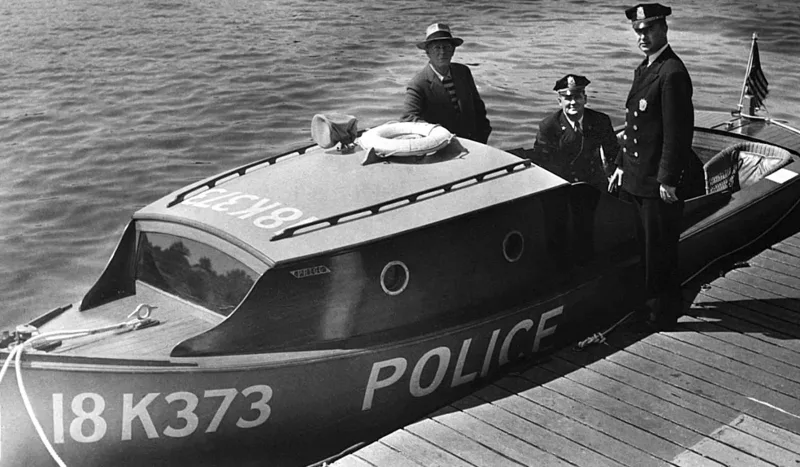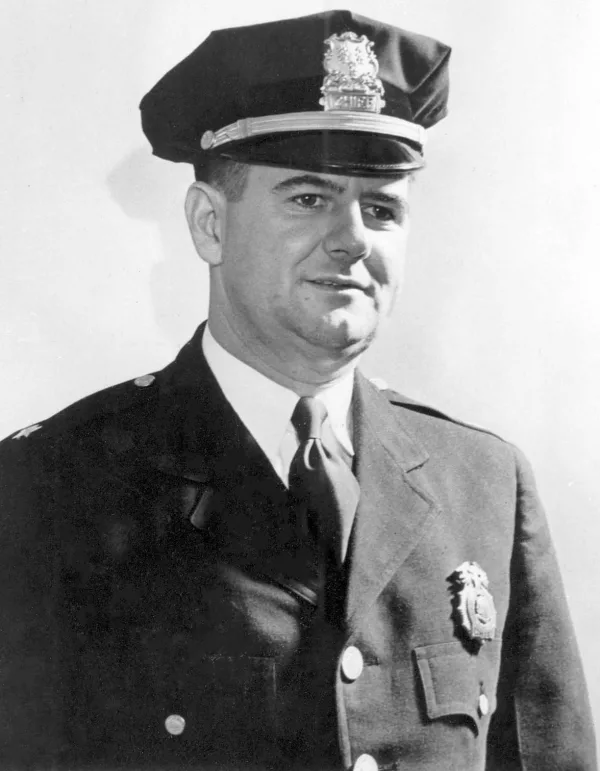
By Mary A. Jacobson
John Gleason, born in 1907 and raised in Greenwich from the age of eight, was the descendent of six generations of blacksmiths in Ireland. However, as he said, “I’m not a blacksmith, but I have another forge I hammer at.” John Gleason’s “forge” was the Greenwich Police Department, where he labored from 1930-1956 from a rookie to Chief of Police. In 1975, Oral History Project volunteer Penny Bott interviewed Gleason as he described his career in the Greenwich Police Department.
In 1926, three years after Gleason graduated from Greenwich High School, the stock market crashed. “It became evident that things were going to go very badly with everybody. No one used the word ‘Depression;’ it later came into use. I thought at the time that, no matter what happens to the country, they’re going to need police. So, I applied and was appointed in January 1930” at the age of 23.
Training and educational requirements for police officers in the 1930’s was far different from today. “The training at that particular time amounted to being called into the chief’s office, handed a small booklet of motor vehicle laws, putting on some other policeman’s secondhand uniform, getting the badge, being sworn in by the selectmen, and being put on a post – all within a couple of hours.”
Regarding educational requirements, “You didn’t even have to have a grammar-school education to be appointed… They were a fine group of police officers of what we term ‘the old school.’ They had come up the hard way.” The expected work week consisted of one day off a month with a 16-hour shift every third Sunday. “You were glad to have a job. You did what you were told, and there was no association or union or anything of that type. You were more or less completely on your own.”
As far as equipment and transportation were concerned, “… there was only one car at that time, driven by the chief. Radio was unheard of.” The police force of approximately 35 officers were quartered in two rooms in the basement of Town Hall.” Gleason’s first responsibility was as a relief patrolman. With no regular patrol cars, police moved from location to location in town by trolley. “When you went out on your post, you got on the trolley at Greenwich Avenue, and you went over to Cos Cob.”
With no ambulance service in the 1930’s, it was difficult to get patients to the hospital. Gleason vividly remembered responding to a victim who had been hit by a vehicle on the Post Road. He had to flag down a random car “to get the driver to help me lift the man off the road before somebody hit him…Then I ran to the Cos Cob firehouse.” Gleason and the firefighter “lifted the man up to the top of the hose (of the open fire truck) and brought him to the hospital… right out in the cold, but there was nothing else to do. We had no ambulances; we had no first aid; we had nothing.” A few years later, the police department operated the first public ambulance in town. “It was an old Model A Ford, called the ‘Black Maria,’ stationed at police headquarters.”
Gleason’s career progressed to that of a plain clothes officer, “checking the back doors of all the stores on Greenwich Avenue and Putnam Avenue… from ten at night to six in the morning… If I would find a door open, the orders were to get to a call box.” If help was needed, “There used to be an old White Stripe Taxi Service on Greenwich Avenue… and they would come in a taxi and pick up a policeman and go off on a call.” Gleason reminisced, “If someone told me at that time that one day a Greenwich policeman (in 1975) would have a little radio around his shoulder, and would be able to talk to headquarters two-way, I’d think they were ready for the nut house!”
At that time in Greenwich, “The only east-west artery was the Post Road. So everybody had to go through this corridor…There was no Merritt Parkway. There was no throughway.” The Post Road was also a major artery for the transportation of alcohol to New York during the Prohibition era. Prohibition, in effect from 1920 until 1933, made the manufacture, transportation and sale of alcohol illegal.

Gleason recalled a particular case, where, working with the federal Alcohol Tax Unit, they followed a truck “with heavily loaded rear springs” on the Post Road carrying ten tons of sugar, only to uncover an alcohol-making operation, over a story high, within a home. “They had taken out the floor of the home and put in a great big copper boiler.” In addition, there were the “local outfits” – a “business that did a little bootlegging on the side, or a butcher shop that kept it in the refrigerator…The complainants in those instances were almost always the wives of the purchasers…They didn’t want their husbands going in and buying liquor, so they’d tell you about it.”
The year 1937 can be described as a watershed year for the Greenwich Police Department. According to Gleason, the Board of Selectman and the Chief of Police commissioned a study by the International Association of Chiefs of Police. The outcome of the study resulted in numerous organizational recommendations. These included the establishment of separate traffic, patrol, safety, and detective divisions, among others. By 1941, Gleason advanced from Deputy Chief to Chief of the Police, the first time such a position was based on the results of a formal examination. “The police commissioner said, ‘You’re the man it’s going to be and it is done on merit’… I was only 34 years old.” Gleason remained in this position until 1956.
As Chief of Police, Gleason oversaw the implementation of many improvements including Red Cross training, updated standards of record-keeping and training, relocation from the basement of Town Hall, uniform traffic ticket procedures, to name a few. Gleason was proud that the department, with outside consultation, produced a “Manual of Procedures” which included police department rules of conduct. As he said, “Your conduct on and off the job is of prime importance…You are an officer at all times.”
John Gleason proudly led the Greenwich Police Department for 15 transformative years. On the occasion of his appointment as Chief of Police in 1941, a local columnist, William Ryan, wrote an ode with a nod to Walt Whitman for the Port Chester Item:
“O Captain! My Captain!/The fearful test is done!/Your mind has weathered every wrack,/
The prize you sought is won./The first is near,/The yells I hear,/The people all are screaming./
The other guys reached for the prize/ But they were only dreaming.”
The interview “A Lifetime of Public Service” may be read in its entirety at the main library. It is also available for purchase by contacting the OHP office. The OHP is sponsored by the Friends of Greenwich Library. Visit the website at glohistory.org. Our narrator’s recollections are personal and have not been subjected to factual scrutiny.
Mary Jacobson serves as blog editor.





